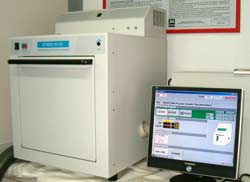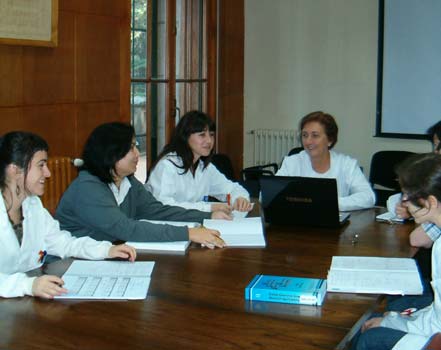One of our team's main concerns is the quality control of all the work performed in our laboratories. Therefore, we have actively participated in numerous inter-laboratory quality programs for certifying reference materials from various national and international organizations.
On the other hand, our team is now involved in the implantation of a R&D Management System based on Norm UNE 166002 for all operations performed in our laboratories.
Teaching activities by most our team members are included within a number of postgraduate programs which have received the Quality Award of the Ministry of Science and Innovation of Spain.
 Quality control in the laboratory
Quality control in the laboratory
 Participation in interlaboratory programmes
Participation in interlaboratory programmes
 Worldwide Interlaboratory Analysis Control “Aluminium”organized by the
Trace
Element Group of the Societé Francaise de Biologie Clinique,
Societè Suisse de Biologie Clinique. Poitiers, France. From 1986 to
1992.
Worldwide Interlaboratory Analysis Control “Aluminium”organized by the
Trace
Element Group of the Societé Francaise de Biologie Clinique,
Societè Suisse de Biologie Clinique. Poitiers, France. From 1986 to
1992.
 Interlaboratory Analysis Control Trace Element in BCR Red Cabbage,
organized by the Sociedad Española de Química Analítica in 1990.
Interlaboratory Analysis Control Trace Element in BCR Red Cabbage,
organized by the Sociedad Española de Química Analítica in 1990.
 Interlaboratory Analysis Control Heavy Metals in solution, organized by
the Sociedad Española de Química Analítica in 1991.
Interlaboratory Analysis Control Heavy Metals in solution, organized by
the Sociedad Española de Química Analítica in 1991.
 Interlaboratory Analysis Control Trace Metals in FD8 Maize Leaves,
organized by the Sociedad Española de Química Analítica in SEQA in
1992.
Interlaboratory Analysis Control Trace Metals in FD8 Maize Leaves,
organized by the Sociedad Española de Química Analítica in SEQA in
1992.
 Participation in Interlaboratory Analysis Control: Certification of
Reference Materials
Participation in Interlaboratory Analysis Control: Certification of
Reference Materials
 The Intercomparison Run P-ACHK for determination of essential and toxic
elements in green algae. Institute of Radioecology and Applied Nuclear
Techniques. Kosice, Checoslovaquia. 1989.
The Intercomparison Run P-ACHK for determination of essential and toxic
elements in green algae. Institute of Radioecology and Applied Nuclear
Techniques. Kosice, Checoslovaquia. 1989.
 The
Intercomparison Run P-Alfalfa for determination of essential and toxic
elements in Lucerne. Institute of Radioecology and Applied Nuclear
Techniques. Kosice, Czechoslovakia. 1989.
The
Intercomparison Run P-Alfalfa for determination of essential and toxic
elements in Lucerne. Institute of Radioecology and Applied Nuclear
Techniques. Kosice, Czechoslovakia. 1989.
 The
intercomparison of essential and toxic elements in wheat and Rye Bread
Flows. Institute of Radioecology and Applied Nuclear Techniques.
Kosice, Czechoslovakia. 1991.
The
intercomparison of essential and toxic elements in wheat and Rye Bread
Flows. Institute of Radioecology and Applied Nuclear Techniques.
Kosice, Czechoslovakia. 1991.
 Key comparison
CCQM-P86.11 Analysis of total Se and selenomethionine in selenised
wheat flour. LGC, Setting Standards in analytical Science. UK. 2008.
Key comparison
CCQM-P86.11 Analysis of total Se and selenomethionine in selenised
wheat flour. LGC, Setting Standards in analytical Science. UK. 2008.
 Intercomparison of trace and minor elements in IAEA Mixed Human Diet
(H-9). International Atomic Energy Agency, Austria.
Intercomparison of trace and minor elements in IAEA Mixed Human Diet
(H-9). International Atomic Energy Agency, Austria.
 Intercomparison of Cd and other elements in IAEA Horse Kidney (H-8).
International Atomic Energy Agency, Austria.
Intercomparison of Cd and other elements in IAEA Horse Kidney (H-8).
International Atomic Energy Agency, Austria.
 Proficiency Test for the determination of trace elements in IAEA-338
lichen. IAEA.
Vienna, Austria. 2002.
Proficiency Test for the determination of trace elements in IAEA-338
lichen. IAEA.
Vienna, Austria. 2002.
 Characterization study of BCR-710 (Sn in oyster tissue). Commission of
the European Communities. Joint research Centre. Institute for
Reference Materials and Measurements (IRMM), Brussels. Belgium. 2007.
Characterization study of BCR-710 (Sn in oyster tissue). Commission of
the European Communities. Joint research Centre. Institute for
Reference Materials and Measurements (IRMM), Brussels. Belgium. 2007.
 Characterization study of ERM-CD281 (Rye Grass) for the total content
of As, B, Cd, Cr, Cu, Hg, Mg, Mo, Ni, Pb, Sb, Se, Sn and Zn. Commission
of the European Communities. Joint research centre. Institute for
Reference Materials and Measurements (IRMM), Brussels. Belgium. 2008.
Characterization study of ERM-CD281 (Rye Grass) for the total content
of As, B, Cd, Cr, Cu, Hg, Mg, Mo, Ni, Pb, Sb, Se, Sn and Zn. Commission
of the European Communities. Joint research centre. Institute for
Reference Materials and Measurements (IRMM), Brussels. Belgium. 2008.
 Characterization study of ERM-CD141 (Calcareous Loam Soil) for the
total content of As, Cd, Co, Cr, Cu, Hg, Mn, Ni, Pb and Zn. Commission
of the European Communities. Joint research centre. Institute for
Reference Materials and Measurements (IRMM), Brussels. Belgium. 2008.
Characterization study of ERM-CD141 (Calcareous Loam Soil) for the
total content of As, Cd, Co, Cr, Cu, Hg, Mn, Ni, Pb and Zn. Commission
of the European Communities. Joint research centre. Institute for
Reference Materials and Measurements (IRMM), Brussels. Belgium. 2008.
Quality in education

Participation in intercomparison
exercises for
students
 Intercomparison exercise for students of Analytical Chemistry,
organized by University of Barcelona (2003-2004)
Intercomparison exercise for students of Analytical Chemistry,
organized by University of Barcelona (2003-2004)
 Intercomparison exercise for students of Analytical Chemistry,
organized by University of Barcelona (2004-2005)
Intercomparison exercise for students of Analytical Chemistry,
organized by University of Barcelona (2004-2005)
 Intercomparison exercise for students of Analytical Chemistry,
organized by University of Barcelona (2005-2006)
Intercomparison exercise for students of Analytical Chemistry,
organized by University of Barcelona (2005-2006)
 Intercomparison exercise for students of Analytical Chemistry,
organized by University of Barcelona (2006-2007)
Intercomparison exercise for students of Analytical Chemistry,
organized by University of Barcelona (2006-2007)
Active participation in the Chemistry Ph.D. Programme which received the Quality Award of the Ministry of Education, Science and Technology of Spain. This programme was organized by the Faculty of Chemistry of the University of Santiago de Compostela until 2006.
Active participation in the Master in Advanced Chemistry programme which has received the Quality Award of the Ministry of Science and Innovation of Spain. This programme forms part of the Postgraduate Programme of Chemistry and Chemical Technology, organized by the Faculty of Chemistry of the University of Santiago de Compostela. Since 2006.
